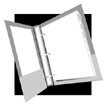|
|
Syllabus
Course Materials See the Supply List
Course Description Prerequisites -- None Using an outline of terms and concepts, and basic black and white and gray materials, students will explore the basic elements of art and the commonly acknowledged principles of design in the 8.5" x 11" format. Assignments will be a range of design problems that can be solved eloquently using the outline as a guide for experimentation. Slides of art from Modern and Post-modern times will be shown during the review of terms at the beginning of each unit to expose the student to the variety of finished products that resulted from their current study. Examples of excellant student work will illustrate the assignment sheets.
Course Objective To put together a Sketchbook (2" three ring binder) of the basic visual and verbal language of art.
Course Policies
Lab Fee The art department charges a lab fee to be used for expendable materials used throughout the art facilities.
Lab Safety and Cleanliness Policies Art materials can be dangerous if used incorrectly. Please follow the directions on the product and exercise common precautionary sense. i.e. Aerosol cans are to be sprayed only in properly ventilated areas (the classroom, hallway, etc. does not qualify.) A cleanup moniter will be appointed if necessary.
Assignments/Responsibilities Show up with your supplies. You will have classwork each day, and one homework assignment most weekends.
Course Content and Outlines See the Outlines
Academic Honor Code Students are expected to uphold the Academic Honor Code. The Academic Honor System at the Florida State University is based on the premise that each student has the responsibility to: (1) Uphold the highest standards of academic integrity in the students own work, (2) Refuse to tolerate violations of academic integrity in the University community, and (3) Foster a high sense of integrity and social responsibility on the part of the University community. Go to http://www.fsu.edu/~union/honor.htm for the full text.
Americans With Disabilities Act Show Students with disabilities needing academic accommodation should (1) register with and provide documentation to the student Disability Resource Center; (2) bring a letter to the instructor indicating the need for accomodation and what type. This should be done during the first week of class. For more information about other services available to FSU students with disabilities, contact the Students with Disabilities Resource Center: Dean of Students Department This syllabus and other class materials are available in an alternate format upon request
Bibliography The coursework is a select compilation of other peoples research into the visual nature of art. Click here to browse the growing list of resources used.
|
